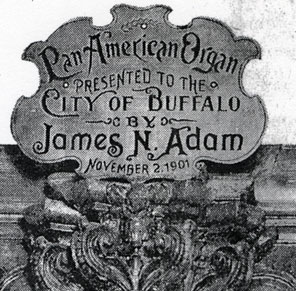
What Happened to the Emmons Howard Organ?

What Happened to the Emmons Howard Organ?
Like almost everything else that could be sold, the great organ was for sale at the end of the Exposition. The Emmons Howard company in Massachusetts had designed it especially for the Temple of Music. A civic-minded Buffalo millionaire, J.N. Adam, whose fortune was made in the merchandise field through his J.N. Adam store on Main Street in Buffalo, stepped forward. After the Pan-American Exposition closed in November, 1901, J.N. Adam saw an opportunity to give his adopted city an enduring cultural gift. He negotiated with the Emmons Howard company, which had built the organ specifically for the Exposition structure at a cost of $18,000 ($507,197 in 2014 dollars), and purchased it at some discount.*
The Buffalo newpapers were jubilant. In his message to Mayor Conrad Diehl on November 9, 1901, J.N. said : "I desire to and hereby present to the City the organ in the Temple of Music. If accepted, it is to be taken down and set up ready for use in any other place agreeable to the authorities."
The obvious location would be the Elmwood Convention Hall which at the time was host to all large public events in the city, including musical performances. The Buffalo Express said of the organ: "It has been played on by Frederic Archer and many of America's finest organists, all of whom agree that it is a fine instrument. It should prove the beginning of a movement that will culminate in a permanent and worthy Music Hall."

Plaque installed in the Elmwood Music Hall above the Adam organ. Image source: Buffalo Courier
The organ was 35 feet wide and, at its highest arch, 44 feet high. It was 35 feet deep. It featured 3,328 pipes and four manuals. Its weight was estimated at between 15 - 29 tons. As may be expected, the City Council immediately began squabbling over the price of installation in the Convention Hall, whether the Hall was environmentally appropriate for the instrument, and why the city was expected to accept the organ in the first place. One Alderman said, "Let's trade it in for a hand organ." Another questioned Adam's political motives in donating it. Antother suggested giving it to "some church." .
Finally, after preparations had been completed in the Convention Hall, including foundation work to support the heavy instrument, the "Adam organ" as it was called was installed on the rear wall of the Elmwood Convention Hall opposite the stage. It made its first concert debut in October, 1902 and served the city's population for the next 36 years. As specified by the Council, free organ concerts were given to the public on alternate Sundays.
Then, in 1938, the Elmwood Music Hall was closed and condemned quite suddenly. Demolition was scheduled; the only thing of value left was the majestic organ. It was carefully dismantled by the Schlicker Organ Company, crated and carefully packed. The company declared that it was "in good condition." Temporarily, it was stored in the city's Cassy Street barns. There was talk of installing the organ in the new concert hall that would be called Kleinhans Music Hall. But the organ needed a major upgrade in its power from a water-based system to an electrical pump system. That problem, and the budget limitations on the new concert hall, foreclosed discussion of re-installing the organ. In 1942, the organ parts, now decayed from improper storage, were put out to bid for scrap. Maxton Metals, Inc. won the bid and paid $165 for the metal pipes.
*According to a history of the organ at Buffalo's St. Louis Church on Main Street, this Emmons Howard organ was ordered and built for final installation in that church. It was first exhibited in the Temple of Music. Minutes of the church trustees document that the organ was too large for the available space in the church, causing St. Louis to back out of the order. I have not seen any reference to this in newspapers. The size problem would likely have been discovered during the Exposition and would explain why no mention of it was made in any of the newspapers after the Exposition closed. It is a puzzlement, however, that a church would order a unique, large, and very expensive organ without agreeing to its dimensions beforehand...
Back to "Doing the Pan" Home